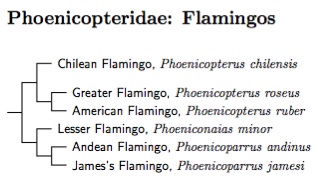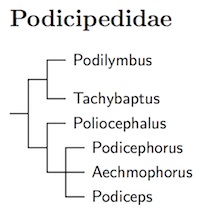NEOAVES Sibley, Ahlquist, & Monroe, 1988
Neoaves is the sister clade to Galloanserae (waterfowl and landfowl). The first division in Neoaves is between Mirandornithes (flamingos and grebes) and the rest of Neoaves. Kuhl et al. (2021) found that division occurred approximately 69.15 mya (72.96 – 66.29 mya) while Stiller et al. (2024) put it around 67.4 mya, with a 95% clade credibility interval of 66.2–68.9 mya. If I took those intervals seriously, I'd insist the divergence occurred before the K/Pg boundary. However, my experience is that calibrated dates are too sensitive to small calibration errors for that to be anything but false precision. I expect the divergence occurred in the very early Paleocene. This reduces the need to explain why no birds other than Neornithes survived the K/Pg extinction.
Mirandornithes Sangster, 2005
Although papers prior to Kuhl et al. (2021) and Stiller et al. (2024) suffer from the apparent polytomy caused by the frozen gene problem (Mirarab et al., 2024), they were able to indentify several supra-ordinal taxa. Mirandornithes (grebes and flamingos) is one of those. What they couldn't do was place it properly in a phylogenetic tree.
Van Tuinen et al. (2001) seem to have been the first to recognize that flamingos and grebes were sister taxa. Their reanalysis of Sibley and Ahlquist (1990) shows that other data to support this association were available earlier, but that the association had been missed by Sibley and Ahlquist, who did not include both of them in any of their individual trees. They did not suspect flamingos and grebes could be closely related.
Later analyses — including Chubb (2004), Cracraft et al. (2004), Ericson et al. (2006a), Brown et al. (2008), Hackett (2008), Gibb et al. (2013), McCormack et al. (2013), Jarvis et al. (2014), Prum et al. (2015), and Stiller et al. (2024) — have also supported Mirandornithes. Further, Mayr (2004) identified morphological and oological evidence in favor of Mirandornithes. See also Mayr (2007, 2008). As with the genetic data, previous morphological investigations also did not consider the possibility of a relationship here. It was just too inconceivable!
Figure ED-2 of Stiller et al. shows the flamingo-grebe split in the early Eocene, at about 53.7±5.1 mya. This, and the obvious differences between flamingos and grebes justifies treating them as separate orders. Kuhl et al. (2021) gave a later date for the split, but the error bars were so large, about 25-64 mya, that their estimate was basically uninformative. Mayr (2014a), using morphological evidence, found that the Eocene Juncitarsus is a stem representative of Mirandornithes. As such, it gives little information about the timing of the flamingo-grebe split, although Mayr suggested middle Eocene.
PHOENICOPTERIFORMES Fürbringer, 1888
Phoenicopteridae: Flamingos Bonaparte, 1831

The genetics of flamingos were studied by Torres et al. (2014). They found that all 6 flamingos shared a recent common ancestor, perhaps 4-6 million years ago. They also recommended sinking Phoeniconaias into Phoenicoparrus, as they considered the distinction between them “arbitrary and uninformative”. The SACC has decided to keep the current genera, and I follow them here.
3 genera, 6 species HBW-1
- Chilean Flamingo, Phoenicopterus chilensis
- Greater Flamingo, Phoenicopterus roseus
- American Flamingo, Phoenicopterus ruber
- Lesser Flamingo, Phoeniconaias minor
- Andean Flamingo, Phoenicoparrus andinus
- James's Flamingo, Phoenicoparrus jamesi
PODICIPEDIFORMES Fürbringer, 1888
Podicipedidae: Grebes Bonaparte, 1831
6 genera, 24 species HBW-1
There's no complete molecular phylogeny of the grebes. However, Fjeldså (2004) provides a morphological phylogeny. Christidis and Boles (2008) have also adopted Fjeldså's phylogeny. For the present, I also use it with some modification based on Ogawa et al. (2015).
Ogawa et al. (2015) found that Rollandia is embedded in Podiceps, so it has been merged into Podiceps. The arrangement within the expanded Podiceps is based on Ogawa et al. (2015).
Bochenski's (1994) osteological study of the grebes found that the Great Grebe is significantly different from the other Podiceps grebes. He created the genus Podicephorus for it. Fjeldså endorsed this view by putting Podicephorus in an unresolved trichotomy with Aechmophorus and the remaining Podiceps. The SACC has yet to consider the issue.
Tricolored Grebe, Tachybaptus tricolor, has been split from Little Grebe, Tachybaptus ruficollis. The subspecies vulcanorum is included in Tricolored Grebe. See Mlíkovský (2010).
Based on Ogawa et al. (2015), the Eared Grebe, Podiceps californicus, has been split from the Black-necked Grebe, Podiceps nigricollis. Ogawa et al. did not find a clear separation between Silvery Grebe, Podiceps occipitalis, and Junin Grebe, Podiceps taczanowskii. Further study is needed to clarify the situation.

- Pied-billed Grebe, Podilymbus podiceps
- Atitlan Grebe, Podilymbus gigas
- Alaotra Grebe, Tachybaptus rufolavatus
- Little Grebe, Tachybaptus ruficollis
- Tricolored Grebe, Tachybaptus tricolor
- Australasian Grebe, Tachybaptus novaehollandiae
- Madagascan Grebe, Tachybaptus pelzelnii
- Least Grebe, Tachybaptus dominicus
- Hoary-headed Grebe, Poliocephalus poliocephalus
- New Zealand Grebe, Poliocephalus rufopectus
- Great Grebe, Podicephorus major
- Western Grebe, Aechmophorus occidentalis
- Clark's Grebe, Aechmophorus clarkii
- Red-necked Grebe, Podiceps grisegena
- Great Crested Grebe, Podiceps cristatus
- Horned Grebe / Slavonian Grebe, Podiceps auritus
- White-tufted Grebe, Podiceps rolland
- Titicaca Grebe, Podiceps micropterus
- Hooded Grebe, Podiceps gallardoi
- Silvery Grebe, Podiceps occipitalis
- Junin Grebe, Podiceps taczanowskii
- Black-necked Grebe, Podiceps nigricollis
- Eared Grebe, Podiceps californicus
- Colombian Grebe, Podiceps andinus